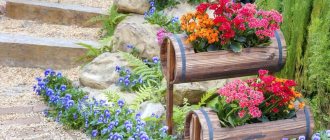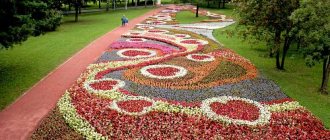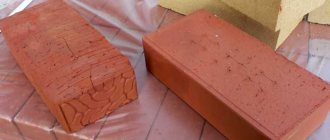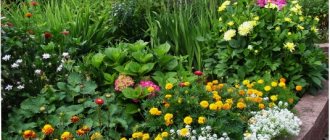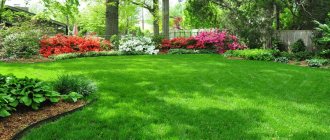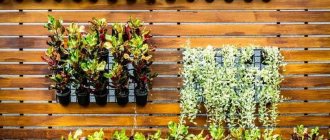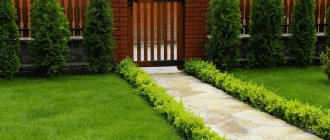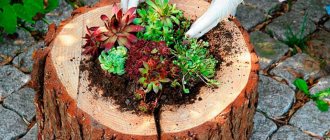Red color in landscape design - for those who like it hot
Psychologists say that shades of red have an irritating effect on the nervous system. Practice shows that the effect on the psyche is not so strong as to change the emotional state.
But the fiery color is great for highlighting, attracting attention, it indicates what should be looked at first. In addition, it is a symbol of beauty, love, energy.
Contemplating red flowers framed by green leaves helps improve your mood. And if in bright sunlight it seems that the red color blinds the eyes, then in cloudy weather it becomes moderately bright, allowing you to admire the subtlety of the structure of the petals. It is recommended to use plants with red flowers in regions with cloudy and rainy summers (Northwestern and Central regions of the Russian Federation).
Red flowers for a flower bed are a real find for those who like to walk through the illuminated garden at night: in warm artificial lighting, shades of red look amazingly beautiful.
Plantings of red annuals will help highlight exactly those areas in the garden that you think are worthy of increased attention.
If the windows of a country house are small, then it makes sense to look at the photo and find out the names of red flowers that can be grown in flowerpots: bright flowers hung around the windows can radically change the appearance of a facade with dim windows.
In flower beds, red flowers look elegant and well-groomed, even if:
- plantings are slightly sparse;
- there are stains on the sheets;
- Some of the inflorescences have dried out.
The best low-growing flowers for the garden
Low-growing crops are great for creating multi-colored flower carpets that organically fit into the landscape design of a summer cottage. The most popular low-growing annual is purslane. It is actively used to decorate rock gardens, borders and rocky gardens. It can also be planted along a fence.
Low-growing flowers are suitable for creating floral carpets
As for low-growing perennial flowers for the garden, it is recommended to give preference to:
- Pansies, excellent for planting along the edges of flower beds;
- Garden periwinkle, popularly called “witch’s violet”;
- Multi-colored phlox blooming profusely all summer.
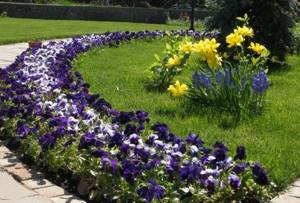
Pansies for decorating the edges of flower beds
Multi-colored cornflowers, beautiful daisies, yarrow and large-flowered flax will organically complement and successfully decorate both flower beds and the entire summer cottage. The alpine aster looks great at the dacha. You can plant it anywhere, including in hanging lawns. This flower is great for making bouquets.
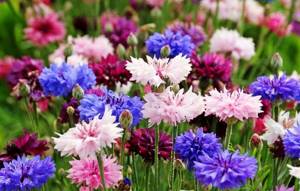
Multi-colored cornflowers will decorate your summer cottage
Red flowers: photo and description
Let's look at red annuals for flower beds; names and photos will help you remember the most interesting ones and use them when planning garden compositions.
Adonis - used to decorate gardens since the 17th century.

It is sown with seeds, which can be stored for only 1 year. Adonis love light soils and morning sun, they rarely get sick and are practically not affected by harmful insects. Can be grown as a perennial.
Antirrinum, better known as Snapdragon.
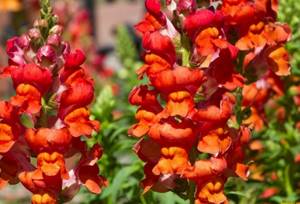
It has been cultivated for more than half a millennium; during this period, hundreds of its varieties have been created, including those with red flowers. In warm climates, the seeds are sown in the ground; in the central zone, it is better to plant snapdragons as seedlings. It is advisable to choose a site for planting that is protected from the winds. Twice a season the bushes are fed with complex fertilizers. Tall varieties of snapdragon require garter.
Asters for a flower bed with red flowers can be chosen miniature (up to 20 cm high) and tall (up to 120 cm high).
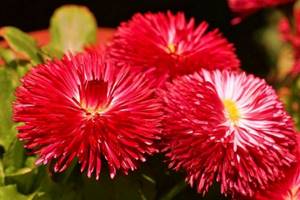
The leaves and flowers themselves may also differ significantly. Asters are sown in the ground or under a film cover. The plants respond well to transplanting and picking, so excess bushes can be planted throughout the area. It is not recommended to plan to plant asters in areas that are too wet. Fresh manure should not be used to fertilize asters.
Balsam.
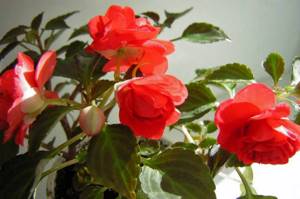
Its lush bushes are worthy of decorating any flower bed. It grows slowly, so it is advisable to plant it as seedlings. Seedlings require picking; mature seedlings are pinched. Caring for balsam involves systematic watering and loosening the soil around the bushes.
Begonia is usually grown in hanging flowerpots, but if planted in an area protected from the wind and systematically fertilized with potassium-phosphorus compounds, the flower can be grown in open ground.
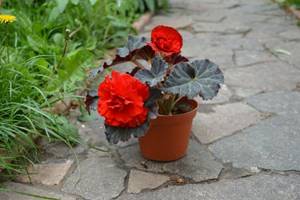
Before sowing, the seeds are treated with fungicides; after the appearance of 2 true leaves, the seedlings are planted in separate pots.
Verbena attracts attention with its long flowering, until mid-autumn.

Pinching the branches and removing fading inflorescences will allow you to get a bright blooming bouquet with a diameter of about half a meter. Verbena is planted as seedlings; during the flowering period and before it begins, the plants are fed with a mixture of Agricola and nitrophoska.
Nasturtium is a plant without special requirements for soil and care.
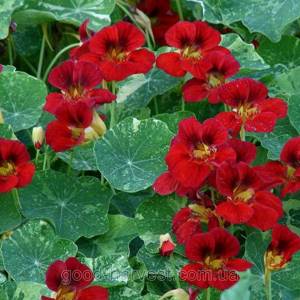
It forms a beautiful bush in any weather conditions and can bloom before the onset of cold weather. Nasturtium is sown in the ground, the sowing density is adjusted depending on the varieties, and they can be dwarf, bush or climbing. The latter are used to decorate gazebos and pergolas. In hot weather, the bushes are watered and fed with potassium-phosphorus fertilizers 2-3 times per season.
Nemesia can be grown in flowerbeds, flowerpots or pots.

They are planted as seedlings; to obtain beautiful bushes you will need to pinch the branches several times. Nemesia is fed with complex fertilizers a couple of times per season. The plant requires systematic watering.
Zonal pelargonium blooms luxuriantly and for a long time, looks good in flowerpots and in group plantings.
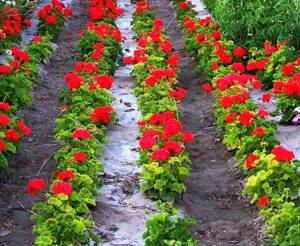
The easiest way to plant it is by cuttings, but you can sow the seeds in March and get seedlings. Pelargonium prefers areas open to sunlight and abundant watering. To maintain the beauty of the bushes, it is recommended to systematically remove wilted inflorescences.
Petunia is a favorite and widespread plant.
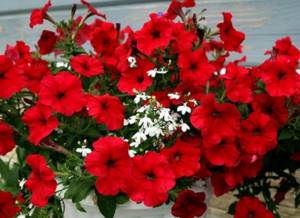
Its large flowers can be red, or purple-black, or a combination of scarlet and white. Petunia is extremely resistant to adverse weather conditions and is undemanding to soil. You can sow seeds in the ground, or you can plant seedlings for early flowering. For feeding bushes, Kemira, Mortar, and nitrophoska are used. Petunia loves watering and frequent fertilizing, loosening the soil.
Salvia, or sage, is a medicinal plant, but is now used as an ornamental plant.

Today there are more than 900 varieties, the brightest of which is Turbo red. Salvia is planted as seedlings, during the growing process of which they use picking. Prefers light soils and well-lit areas. Salvia is watered infrequently; fertilizers will need to be applied during budding.
Phloxes are attractive due to their ease of care and bright flowering, lasting from June to September.
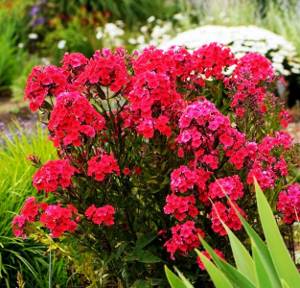
They are planted in the ground as seedlings, the distance between the bushes should be at least 0.3 m: adult well-groomed bushes have respectable dimensions. Plants are fertilized three times a season with a nitrophoska solution. Watering should not overly moisten the soil. To extend the flowering period, it is recommended to remove fading inflorescences.
Celosia is grown by seedling method.
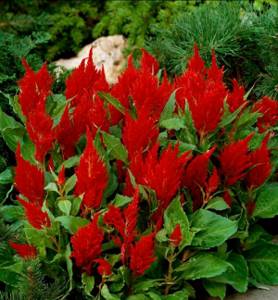
The plant is very bright, the word itself translated from Greek means “fiery”. When grown in open ground, fertilizing is carried out every 3 weeks, complex fertilizers are used. Throughout the growing season, the bushes are watered and the soil around the bushes is loosened.
Zinnia is one of the most popular annuals.
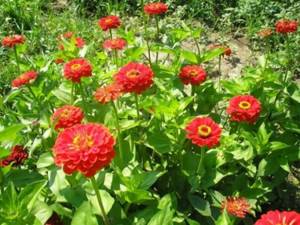
The easiest way to grow seedlings is in peat pots and plant them in well-fertilized soil in May. To obtain lush, long-lasting flowering, Zinnias are watered daily in the evening with well-settled water and fed with complex fertilizers once every 3-4 weeks.
Low-growing, long-flowering perennials
Low-growing perennials take root well in any soil. There is a separate group of colors for rocky and sandy soil. Flowering plants do not require frequent feeding; it is enough to apply fertilizer a couple of times throughout the summer.
Important! When choosing low-growing perennials for the garden, it is worth considering their compatibility.
Pansies
Viola, Wittrock's violet or Pansy is a garden perennial. Low bush with dark green leaves. The flowers are solitary, the petals can be purple, pink, white, blue. There are varieties with a single color or spotted.
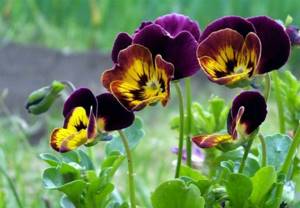
The perennial violet blooms early and looks good next to primroses and spring primroses. Suitable for decorating balconies, terraces or garden paths. Does well in sunlit areas, but tolerates light shade. Can be planted under trees with a sparse crown.
Armeria seaside
This is a low-growing perennial, the height of which ranges from 20 to 60 cm. Its leaves are collected in dense basal rosettes, forming entire clumps. The low-growing armeria blooms with small flowers collected in spherical inflorescences. The color of the petals can be pink, white or purple.
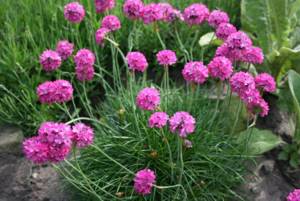
Armeria seaside loves high air humidity, so it is recommended to plant it along reservoirs or artificial ponds. The low-growing perennial does not require special care; it is replanted every 5 years.
Astrantia large
This is a rhizomatous flowering perennial, its stems are weakly leafy and practically do not branch. The height of the bush reaches 90 cm. The leaves are serrated, divided into 3 or 7 lobes. The inflorescences are simple, umbrella-shaped, and consist of many small flowers.
Astrantia is an excellent honey plant that tolerates frost and dry periods well. Suitable for planting as a tapeworm on the lawn, in ridges or mixborders. Pairs well with geraniums, heucheras, hostas and astilbe.
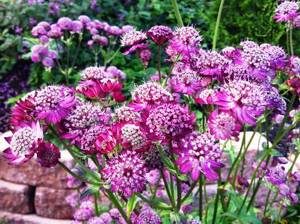
Attention! Low-growing astrantia flowers are often used as dried flowers.
Arenaria crimson
Arenaria or chickweed is a flowering, unpretentious perennial. Its adult height does not exceed 35 cm. Its stems are long, intertwined well, and form a dense cushion. The flowers are simple, small, collected in inflorescences. The color of the petals is white.
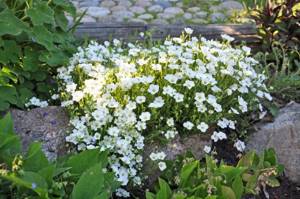
For planting low-growing arenaria, a bright place in the garden is allocated. The soil is preferably sandy or sandy loam. Water it rarely to prevent stagnation of moisture. No feeding required.
Primrose
Primrose or primrose is an unpretentious perennial. The bush is short, does not exceed 20 cm. The leaves are pubescent, collected in a rosette. The flowers are simple, of different shades. They can be plain or variegated.
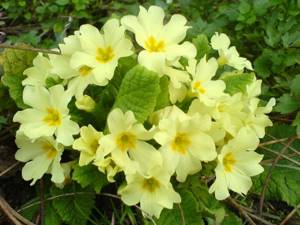
Primrose prefers sparse shade, so it is planted under trees, ornamental shrubs, and large perennials. The soil for primroses should be loose and nutritious. In order for the flowering to remain vibrant, the bush must be replanted annually after flowering.
Phloxes
Low-growing phloxes do not exceed 30 cm in height. The perennial stems are erect. The flowers are simple, collected in inflorescences. Their color is varied. There are up to 90 flowers in one inflorescence.
Growing phlox is not difficult. Flowers respond well to fertilizing and do not require abundant watering, except on hot days. Bushes are replanted every 7 years.
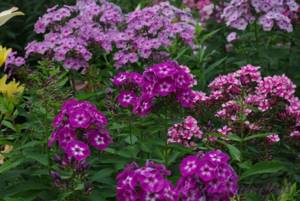
Warning! If in winter the temperature drops below -25°C, then the phlox root system will die without additional shelter.
Smolevka
Smolevka is a low-growing herbaceous perennial that blooms profusely all summer. The flowers are inconspicuous, star-like, no more than 3 cm in diameter. They can be white, pink, or cream. More than 500 species of resin are known.
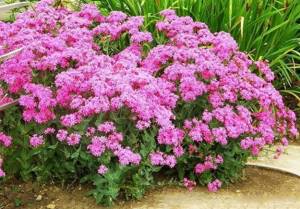
Tar is used in landscape design, as ground cover mats. The bushes form dense thickets that require virtually no maintenance. It tolerates drought and frost well, does not require frequent watering, but will not refuse fertilizing during the flowering period. Plant low growing gum in partial shade, since the afternoon sun is destructive for it.
Perennial chrysanthemum
One of the beautiful low perennials is the chrysanthemum. Flowering bushes decorate the garden from mid-summer until late autumn. There are many varieties and species of this plant. Flower baskets can be plain or variegated, painted in different colors.
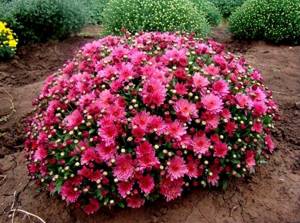
The place for planting low-growing chrysanthemums is chosen to be bright and well-lit. In the shade, the shoots stretch out, and flowering is delayed for several weeks. Chrysanthemum is combined with spring bulbous flowers, hostas and other decorative foliage crops. Looks good along paths.
sedum
The name “sedum” hides a whole group of perennials, most of which are suitable for growing in the garden. These are shrubs, subshrubs or creeping flowers. Sedum or sedum is a close relative of Kalanchoe and Juvenile. All its species overwinter well in open ground and tolerate drought and bright light. However, when planted in shaded areas of the garden, they also develop well.
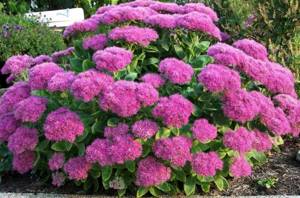
Care for sedum in the garden is minimal. It does not need to be weeded often; the roots release caustic substances that independently destroy weeds. Low-growing sedums are used to decorate flower beds and paths; creeping types are suitable for rock gardens and rockeries.
Nepalese cinquefoil
This is a low shrub of the Rosaceae family. It is used as a tapeworm on the lawn, hedges, and for decorating flower beds and paths. The shoots of the cinquefoil are erect, the leaves are pinnate, and colored dark green. The flowering of the bush begins in May and continues until September. Bright yellow flowers with 5 petals are formed at the ends of the shoots.
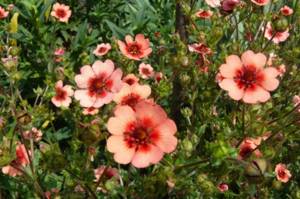
Caring for perennial cinquefoil is not burdensome. It does not require frequent watering; the soil is moistened only during periods of drought. In summer, low-growing shrubs are fed with humus, using it as mulch.
Dianthus carnation
Low bushes of perennials are used to border flower beds. The flowers of carnation grass look especially impressive. It is often used for rockeries. It grows quickly and requires absolutely no maintenance. Grows well on any soil. The average lifespan of a bush is up to 7 years.
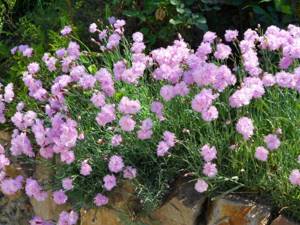
Important! The winter hardiness of carnation grass is high. The bushes tolerate temperatures as low as -35°C.
There are many varieties of carnation grass. There are varieties with double inflorescences and continuous flowering.
Balkan geranium
This garden perennial reaches a height of 50 cm. It blooms in the first summer months. The flowers are simple, painted in bright colors. Geranium leaves are toothed and have a characteristic aroma. The flower looks especially impressive in autumn. Geraniums are used for planting in rocky gardens and rock gardens. It braids stones well.
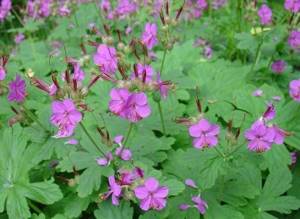
Features of growing low-growing perennials
When growing low-growing perennials in the garden, it is difficult to meet all the ecological needs of the flowers. It is impossible to change the weather, length of daylight hours and other conditions. But it is possible to influence the composition of the soil. Soil conditions are one of the important points in growing low-growing perennials. And this is worth paying special attention to.
For crops that prefer loose soil, the soil should be prepared in advance. It is enriched with nutrients, dug up, and sand is added if necessary.
It is better to plant low-growing perennials in autumn or spring; cuttings or small cuttings are used for planting. The flowers develop well, so you shouldn’t plant them too close. They will begin to oppress each other.
Advice! You can supplement a flowerbed with low-growing perennial plants with annual plants so that it looks harmonious and is continuously in bloom.
In the first year, immature, low-growing plants require special attention. They are watered abundantly, especially during periods of drought, and mulched if necessary. Feeding is carried out only after the perennials have taken root well in the new place. In the first year (autumn), even the most winter-hardy of them need shelter.
Low-growing perennial crops with red flowers
A bright scarlet accent on the most important areas of the garden is an ideal solution for those who are brave and not afraid to experiment. We invite you to get acquainted with the most popular perennial plants, caring for which will bring real pleasure to amateur gardeners.
Low-growing plants are used to decorate borders, alleys, paths; they will perfectly complement the relaxation and recreation area.
Primrose blooms with the onset of the first warmth of spring.

The leaves are pubescent, wrinkled, the flowering is extremely bright and lush. It is recommended to plant the crop on light soils; bushes can be propagated by cuttings, seeds, or division. The distance between the bushes when planting is about 15 cm. The height of adult bushes reaches 10-30 cm, flowering lasts for a whole month, from the first days of April to May.
Cinquefoil is blood red.

The height can reach half a meter, it has a straight, branched stem. It is distinguished by very bright flowering and a beautiful rich shade of green leaves. The flowers are large, up to 5 cm in diameter, collected in paniculate inflorescences. It blooms in June-July, flowering duration is up to 50 days.
Border chrysanthemums, they are also called Chinese.

They are attractive due to their long flowering period and resistance to cold. The bushes are low-growing, up to 30 cm tall, and have a spherical shape.
Planting low-growing perennial flowers yourself
Every owner of a summer cottage dreams that her territory looks neat and beautiful. Of course, a summer cottage can become beautiful after flowers and various ornamental plants appear on it. It is worth noting that today there is a huge selection of flowers for a summer cottage. But in this article we will tell you about which perennial flowers to choose for your flower bed that bloom all summer. And here we will present for you low-growing varieties of these plants.
Benefits of low growing flowers
There are many advantages to planting and further growing low-growing plants.
- First of all, they look very neat and beautiful in the flower garden.
- Secondly, with the help of these plants you can create a variety of compositions.
- Thirdly, caring for them is very simple.
Those people who have chosen low-growing flowers wish that they could decorate their garden plot throughout the summer season. And there are quite a lot of these plants. And today we will try to list all such plants.

The main principles of caring for low-growing flowering plants
Flowering perennial, low-growing flowers are special plants. Each flower requires a special approach. But there are specific recommendations for those people who want to create beautiful and original flower beds using low-growing flowers.
- One of the most difficult problems that many amateur gardeners face is pulling. The very long stem of the flower only spoils the overall appearance of the entire composition, and its leaves, which completely cover the rest of the flowers from the sun’s rays, have a bad effect on their growth.
- The second important problem is the very rapid growth of leaves that hide the flowers. When this situation occurs, a beautiful and colorful flower garden resembles a simple green bump with small specks of color.
The problems described above can be easily avoided if you follow a few simple rules:
- Do not overfeed flowers with nitrogen-containing fertilizers. These fertilizers will perfectly stimulate plant growth, but they are unlikely to increase the number and size of flower stalks.
- It is necessary to use special fertilizers intended for flowering plants. They are not new at all. Based on this, buying them will not be difficult.
- When planting, try to place seeds or seedlings at a short distance from each other. Excess density can serve to lengthen the plant stem, since the flowers will simply be very crowded.
- Do not plant flowers that do not like it in the shade. This will also cause the stem to lengthen.
- If the flower requires pruning, carry out this procedure according to the prescribed schedule.
- There are plants that need trimming of wilted tops and leaves. This is necessary so that they cannot grow.
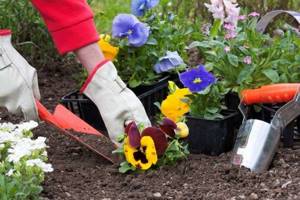
Annual low-growing plants that decorate the garden plot all summer
Despite the fact that these plants live for only one summer season, throughout this period they will perfectly cope with their decorative function. The flowering of these plants will be continuous. For this reason, creative people should pay attention to these annual flowers. With the help of these flowers, you can create beautiful and original flower beds every year. If you properly care for annual flowers, they will delight you with their beauty all summer long. Annual flowering plants can be divided into two main groups based on the beginning of flowering:
- Spring. Petals and buds of flowers in this group appear with the onset of spring. These include flowers such as petunia and begonia.
- Summer. The buds of these flowers will appear only with the onset of summer. This list includes: cornflower, marigolds, zinnia.
- There is also a 3rd group. It includes low-growing annual plants that bloom before the onset of the first cold weather. This group includes: snapdragons and asters. Here is a list of beautiful annual flowers:
Pansies. This flower has an original and extraordinary color with a yellow center. The colors of its petals come in a variety of colors. This is the rule. Depends on the plant variety.

Snapdragon. An excellent option for those people who are looking for a small semblance of a gladiolus. This is a vertical flowering plant. A distinctive feature of snapdragon is its wide range of warm colors. You can choose red, yellow or pink.
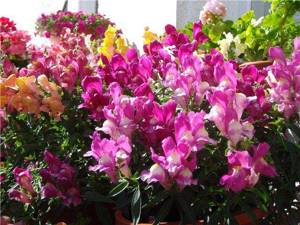
Iberis. This flower is best suited for creating contrasting flower beds. Beautiful white clouds of flowers will perfectly highlight the beauty of the bright petals of neighboring plants.
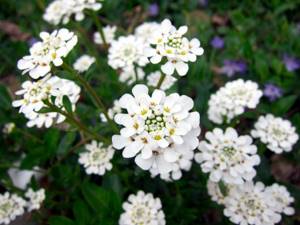
Daisy. Small delicate flowers with thin petals. The color can be chosen to suit every taste.
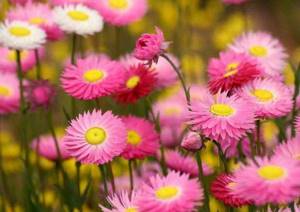
Nemophila. These flowers are best suited for creating original and extraordinary flower beds. The middle of this flower has a white tint. The edges are a soft heavenly color.
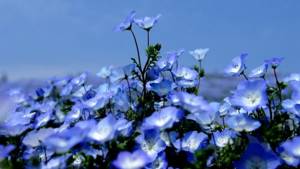
Petunia. If you are looking for large and beautiful flowers in hot pink, snow white or deep purple? You should choose petunia.
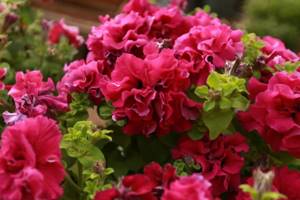
Marigold. These flowers are a must-have for those who love warm colors and delicate textures. One such flower can contain all the colors at once: from bright yellow to dark red.
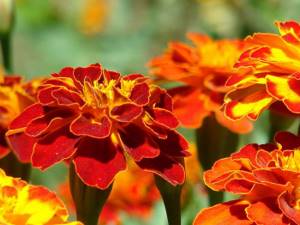
Ageratum. A very original solution for those people who appreciate soft and delicate textures. These plants in appearance resemble fabric balls from which fluffy and warm sweaters are made. The color palette of these plants is cool (pink, blue and lilac shades).
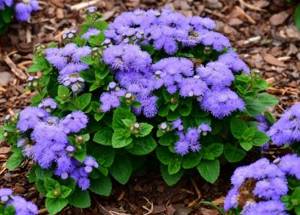
Lobelia. The main advantage of this plant is its large variety of flowers. Due to their quantity, leaves and soil are practically invisible.
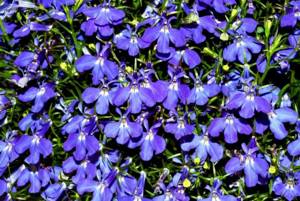
Perennial plants that bloom throughout the summer
Low-growing perennials are exactly the flowers that conservatives like best. If you have already chosen the design of your country landscape and do not want to change the flower beds, stop at these colors. We bring to your attention several interesting low perennials that will look beautiful bright spots on your site all summer.
Gentian. Bright blue-blue flowers that look like bindweed. An excellent option for decorating the ground.
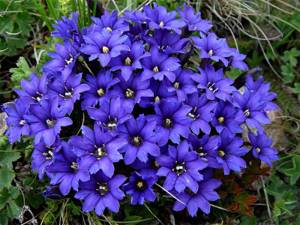
Phlox. Large and lush balls of flowers collected together are suitable for creating a voluminous flower bed. Their color palette ranges from soft white to bright purple.
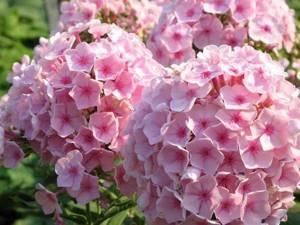
Aubrieta. The low bushes of this plant are distinguished by the unique beauty of their bright purple flowers.
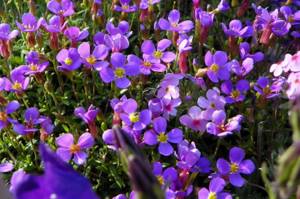
Carpathian bell. If you want to create a beautiful and picturesque bright blue border on your site, then purchase the seeds of this plant.
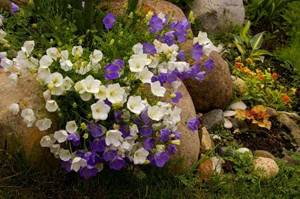
Aquilegia. The beauty and extraordinary appearance of this flower lies in its original structure. In its center there is a yellow core surrounded by oval-shaped petals. Behind them are pointed petals.
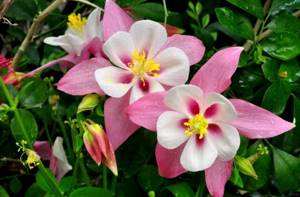
Malnyanka. This flower is most suitable for creating flower beds in pink tones. Each of them has five petals.
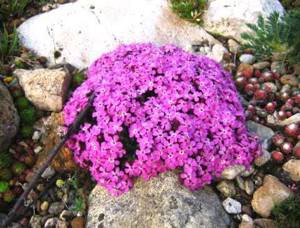
Dwarf aster. An excellent option for those who dream of the beauty of their garden landscape, even in autumn. This type of aster has snow-white, lilac, dark pink and purple colors. The flower is practically no different from the standard aster, only in the size of the bud.
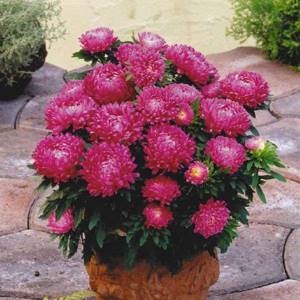
What flower beds can be made from annual flowers?
The main advantage of annual flowers is the opportunity to experiment almost every year. Imagine and create bright, carpet flower beds of various shapes and forms.

Flowerbed butterfly. An interesting and original variation of the flower bed is the butterfly. First, we advise you to draw a drawing of a butterfly on paper, and only after that should you make markings on the ground.

The simplest option is a flower bed in the shape of a heart. It is quite simple to make, since it does not have clear boundaries. If the area of your garden plot allows you to create a large flower arrangement, then choose the option of a carpet flower bed like this.
Original flower beds of low-growing perennial flowers
It’s already clear what low-growing perennial flowers to choose for a flower bed that bloom all summer. Now we will tell you how to organize attractive flower beds from them. Perennial flowers are well suited for creating flower bed islands. These flower arrangements do not have clear contours. For this reason, you can plant the selected plants and not worry about the general condition of the flowerbed for a long time. We offer you the option of a colorful flowerbed-island, which is created from flowers of various shades.
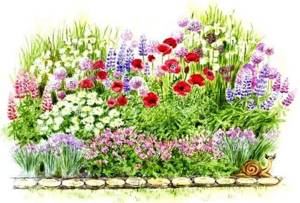
How to combine flowers in flower beds.
Almost anyone can do color combinations. It is much more difficult to choose flowers for a specific flower garden. The information below contains some options for figured compositions of flowers and plants that can be used.
Flowerbed - Heart. Flowers: Pink petunias can be placed in the middle. The first circuit contains lilac phloxes, and the second circuit contains purple ones.
Flowerbed-Chamomile. Flowers: In the middle of the flower bed you need to plant yellow marigolds and five white Iberis petals.
Flowerbed-Sun. Flowers: snapdragon is located in the middle, and marigolds act as rays.
And the following information will allow you to choose a beautiful combination to create a border flower bed that can decorate the area near a hedge or path.
Flowerbed - Lilac hedge . The area next to the hedge has bright purple pansies. The second row contains violets.
Flowerbed - Heavenly tones. The row near the hedge is planted with nemophila. In the second row there is a blue ageratum.
Flowerbed-Tenderness. Dwarf asters of different colors are planted in a row located near the hedge. In the second row are white phloxes.
Finally
Choose the best low-growing perennial garden flowers for your garden plot. Using them, create original flower beds that can make your dacha truly beautiful.
Video on the topic: Perennial flowers for the flower bed. Titles + photos
Also read:
- How to grow perennial plants for your garden
- We arrange beautiful flower beds ourselves and…
- What annual flowers bloom all summer. Catalog…
- Catalog of unpretentious and small perennials.…
- What perennial unpretentious flowers exist for...
- Arranging flower beds at a summer cottage. The best ideas with photos
- What climbing plants to plant near the gazebo
- We make unusual flower beds on a summer cottage from...
Tall perennials
When creating mixborders and flower beds, it is customary to use tall plants with bright flowers.
Heleniums, or red daisies, are members of the Asteraceae family.
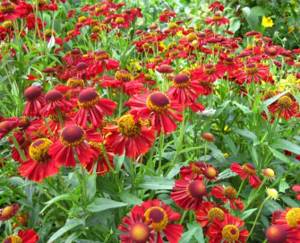
The height of the bushes can reach one and a half meters, but is usually 90 -100 cm. Flowering begins in the second half of summer and lasts up to 6 weeks. Helenium loves abundant watering and fertilizing.
Ornamental garden poppy is a perennial with large double flowers; the height of the bushes can reach 1 m.
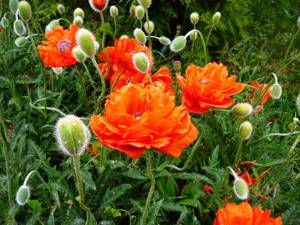
It has very beautiful carved green-smoky leaves. Poppies can be planted on any soil. Planting in swampy and heavily shaded areas should be avoided.
Astilbe belongs to the saxifrage family; the height of the bushes can reach 2 m.
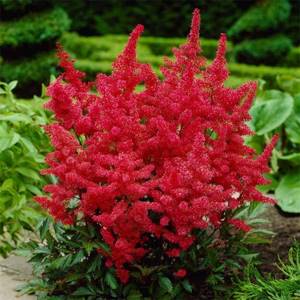
The flowers are of a refined shape, collected in panicle inflorescences. Flowering lasts 15 days; its duration can be increased by planting astilbe in partial shade.
Lychnis chalcedony is a member of the clove family.
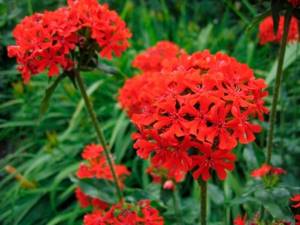
The stem is erect, up to 1 m tall. Small, about 2 cm in diameter, flowers are collected in thyroid inflorescences, flowering duration is 1 month.
Among long-flowering perennials, begonia should be noted.
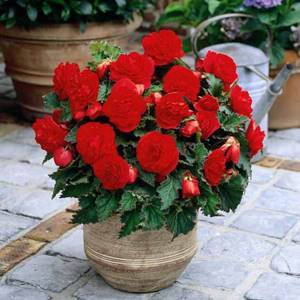
It blooms throughout the summer; the bushes attract with their bright colors and beautiful shape of leaves. The most popular variety is Regal Minuet, which has pearl-cherry flowers.
Centarius, or red valerian.

Bushes reaching a diameter of 0.6 m are recommended to be planted in areas well lit by the sun. Centarius looks very picturesque in rocky gardens and rock gardens. The plant is propagated by seeds or by dividing the bush. The flowering period of Centarius is from June to early September.
The rose is the real queen of the garden; its bright blooms will delight the eye throughout the summer, and even in the fall.
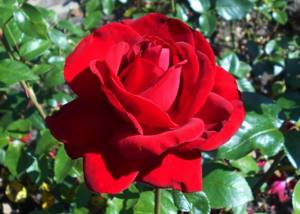
Of course, subject to proper pruning, removal of faded buds, high-quality watering and systematic fertilizing. If symptoms of disease and pest damage are detected on the bushes, it is recommended to immediately treat them with appropriate preparations.
Plants with red leaves look no less attractive against the backdrop of garden greenery:
- Heuchera blood red;
- Coleus Blume;
- Amaranth.
Selecting perennials with red flowers will allow you to create original, exquisite compositions in gardens decorated in different styles.
“The unknown” about the known. Perennials and annuals!
Perennial and annual plants and everything about them.. In our gardens, as a rule, two types of plants grow - perennials and annuals
. Some prefer to use one type, others the other, and some combine both types. Each type of plant has its own pros and cons. Let's look at them.
Annuals.
As their name suggests, annual plants grow for just one growing season, usually from spring to fall. That is, during this time they sprout from seeds, grow, bloom, then produce seeds and die.
They most often have bright flowers, they grow quickly and quickly fill empty spaces in the area. They reproduce only by seeds, vegetatively, i.e. They cannot be propagated using plant parts.
Unlike perennials, they bloom longer and cost less. Using them you can make a variety of designs from year to year. They are ideal for creating flower beds where they will grow all summer long. The only downside is that you will have to plant them every year.
Annuals can be planted both in cold and warm seasons. Cold-season annuals delight with their beauty during the winter in southern regions where there is practically no frost. These include: Viola, better known as pansy, Alyssum, Verbena, ornamental cabbage and others. In warm climate areas they can be planted in late autumn, in cold climate areas they can be planted as soon as the soil is suitable.
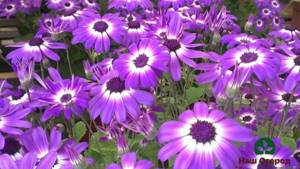
Whatever plant you plant in the garden, do not forget about proper care for it.
Warm-season annuals bloom in late spring, summer and early fall. For example, Zinnia, Eschscholzia, Cornflower, Marigold and others. Because these plants cannot withstand cold, they should be planted in mid-spring unless there is no longer danger of frost.
Because of their rapid growth, annual plants require more nutrients during the growing season than other plants. Therefore, use complex fertilizer when planting. If you live in a temperate climate, add nitrogen fertilizer when plants begin to bloom and in late summer. In cold weather, feed as soon as the plants begin to bloom. But be careful not to overdo it.
If you buy seedlings of annual flowers, look for plants with brightly colored foliage. The roots should not be overgrown or tangled. Although plants with lots of flowers are very attractive, don't stare at them. It is better to choose plants with fewer buds. They will have more energy to form a good root system.
Popular types of annual plants.
Petunias - These incredibly fast-growing flowers come in a wide variety of varieties and colors. It can bloom in spring and until late autumn. There are bush and hanging (cascade) varieties. Marigolds are a bright and sunny annual that attracts insects to your garden to pollinate plants. The most popular colors are orange or yellow. Pansies range in color from pink, purple to orange and red. Can withstand low temperatures. Begonias are another flower that comes in a wide variety of colors and sizes. The most common begonia is with pink, white or red flowers.
Perennials.
They live for three or more growing seasons. In the fall, the plants can be cut back, and in the spring they will begin to grow again from the previous root system. Most of them do not grow as quickly as annual plants, reaching their full growth most often within a year or even two.
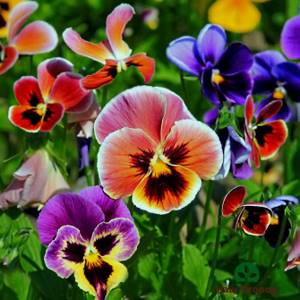
Pansies have many charming shades from soft pink to bright red.
Perennials typically have shorter flowering periods than annuals, so gardeners often combine them with perennials that bloom at other times to maintain consistent color from spring to fall. They can be planted from bulbs or seeds. Grown from seed, plants usually do not produce flowers the first year.
It is best to plant in early spring or early fall, but no later than 6 weeks before frost. Perennial flowers require more care than annual flowers. They must be closed in the winter so that the root system does not freeze. Feed throughout the growing season with fertilizers containing nitrogen and potassium.
Perennial flowers or plants can be divided into tender and hardy. Tender perennials such as gladioli and dahlias cannot withstand winter conditions and frost. These perennials are harvested in the fall and stored indoors until the first frost, then replanted after freezing temperatures have passed. Hardy perennials, unlike tender ones, can survive frosts and can be kept outdoors throughout the winter season.
Popular types of perennial plants.
Daffodils are one of the earliest spring flowers, similar to the sun. Tulips also bloom in early spring. It has a wide variety of colors (white, pink, red, yellow, multicolor) and shape (double, fringed, simple, lily-flowered). Hyacinths are beautiful bulbous plants, mostly white, pink or blue. Numerous flowers are located on the stem of the plant. Chrysanthemums mainly bloom in autumn. Flowers are orange, purple, red or white.
If you do not grow seedlings yourself, then perennial plants in the nursery will cost you more than annual ones, since more effort and time are invested in their cultivation. Also, perennial plants do not bloom during the first year of their life, so in nurseries, they are cared for over a long period of time. It could be months or even years before they can sell them. But despite the cost, it is profitable to buy perennial plants, since they do not need to be replaced every year.
Regardless of what you choose for your garden, do not forget to take into account the sun and water needs of each plant. For example, there are shade-loving species that grow well in the shade, while there are light-loving species that cannot grow in the shade. There are plants that tolerate drought well, and others that die immediately. Before planting, be sure to consider the conditions of your garden and choose the flowers correctly!
Tips for decorating a flower bed
First of all, you need to decide on the location of the flower bed, its shape and dimensions. Calculate how many bushes can be placed on it.
To make the flower bed look attractive throughout the spring and summer, you will need to select plants with different flowering periods. If you want to get intense simultaneous flowering of all types, you will have to select varieties whose flowering schedule coincides.
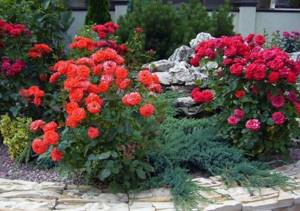
If you want to choose only red flowers for your flower bed, it is recommended to choose crops that differ in shape and color intensity of leaves and flowers. Plants should not be planted randomly. You must first draw up a plan taking into account the characteristics of each type of green space and strictly adhere to it.
To obtain a more advantageous landscape composition, designers still recommend diluting it with bright shades:
- refresh the picture with blue and white colors;
- yellow and red will create an attractive duet that will be difficult to take your eyes off;
- orange will add even more dynamics and energy.
Red flowers for a flower bed can be used low or tall. If desired, you can plant perennial or annual plants that reproduce by seeds. Monochrome compositions composed of varieties that begin to bloom alternately will delight the eye throughout the summer. When choosing plants, you should take into account the duration of their flowering period.
Annuals that bloom all summer
Nature, with the help of gardeners and breeders, has “brought into existence” many varieties of flowering plants that provide their beauty throughout the summer. You can try to grow each of them at your dacha.
We list the most popular varieties of annual flowering plants that can bloom all summer:
- Annual Iberis. Depending on the variety, such a garden plant can reach a height of 15 to 40 centimeters, so it is considered low-growing. Iberis is not a pure flowering plant that will bloom all summer. Its colorful small flowers will decorate your flowerbed for a short time, but they bloom quickly after planting. Therefore, you can plant Iberis several times during the summer, and thereby achieve a constantly blooming flower bed;
- Blue nemophila is a low-growing garden flower, height from 5 to 30 centimeters, a plant that blooms with small bluish flowers. If you plant it in your garden bed, you can admire the inflorescences from June to October;
- Night violet - plant height can reach 40 centimeters. If you plant it in the shade, it will bloom for two months, starting in June. The flowers are small and can be white, lilac or pink;
- Petunias are one of the most common flowering plants. It is unpretentious, has a height of 20-80 centimeters, and blooms for 3-4 months;
- Zinnias are also a fairly popular variety. The plant can reach a height of 90 centimeters. The flowers, which bloom continuously from June to September, come in a variety of colors depending on the variety;
- Marigolds - this flower can often be found in cottages and garden plots. The plant reaches a meter in height, and it blooms from June until the onset of the first frost;
- Dahlias are giants in the world of flowers, their height sometimes reaches two meters. The color of the flowers can be different, everything will depend on the chosen variety. And flowering continues from July until late autumn.
There are many other types of annual flowering plants that give their beauty until late autumn . With their help you can decorate your flower beds and the entire area. At the same time, you can change the appearance of the territory every year. After all, these plants are annuals, which means that every spring you have the opportunity to create new compositions.
PLANTING A GARDEN Everything you wanted to know about DIY landscape design
Added 11/14/2014 perennials, review, form No comments
Decrease text size Increase text size Text size Print Send by mail
Continuing the topic of spherical tree and shrub plants, the idea arose to make a brief overview of representatives of the “herbaceous world”, which have a rounded habit.
Cushion-shaped herbaceous plants . This category includes mainly miniature plants that reach 10–25 cm in height and form compact oval or hemispherical cushions. Since the growth of shoots of cushion-shaped plants is very limited in length, they keep their shape well for several years, so they are successfully used for artistic decoration of borders, rock gardens, rocky areas, and ornamental flower beds.
Plants reveal their greatest decorative potential during flowering. Most representatives of this category are well adapted to unstable climate conditions and are quite hardy in conditions of dry, poor soil, which is a prerequisite for the success of growing them in dry and sunny places, as well as in container culture.
Representatives of this group include:
- Douglas phlox - blooms at the end of May, snow-white flowers are crowned with the White Admiral variety, bright crimson flowers with the Cracker Jack variety, bright pink flowers with the Karkulka variety;

Phlox Douglas 'Karkulka'
- Arends saxifrage - blooms in late May - early June, flowers - white, pink, purple;

Saxifraga Arends
- saxifrage lush - blooms in early May, flowers are bright yellow with an orange tint;

Saxifraga lush
- Iberis evergreen - blooms in late May - early June for 25-30 days, flowers are snow-white, the most decorative varieties are “Little Gem”, “Zwergschneeflocke”, “Dana”.

Iberis evergreen
Richer soils and moister conditions are preferred by the blood-red geranium 'Max Frei', whose spherical shape is rare for geraniums.
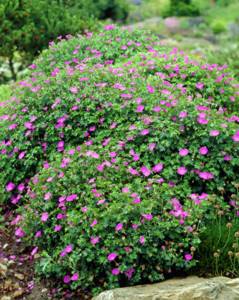
Blood red geranium 'Max Frei'
Low-growing plants with a spherical habit . This category includes plants that reach a height of 25-50 cm. Since the assortment here is much wider than in the previous category, the plants are represented by different ecological groups in relation to growth conditions.
Rich soils are preferred by the Carpathian bellflower, whose dense bushes from June to September are crowned with blue, purple and white flowers up to 5 cm in diameter.

Carpathian bell "DEEP BLUE CLIPS"
«
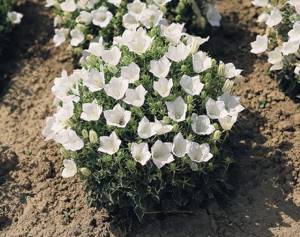
Bluebell Carpathian "Clips White"
«
Among the representatives of spherical herbaceous plants, Euphorbia multiflora is tolerant to low nutrient content in the soil; in addition, it grows well both in the sun and in the shade. Golden-yellow flowers located at the tops of the shoots pass the baton to the bracts, which gradually turn bright yellow.
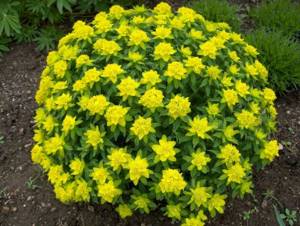
Euphorbia multicolor
Among the biennials with a spherical bush, the forest forget-me-not varieties “Blue Ball” and “Pompadour” are known.
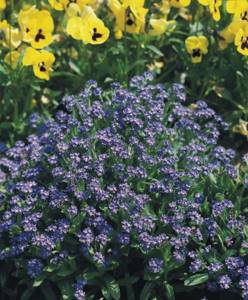
Forget-me-not in the company of pansies
Separately, I would like to note the varieties of shrub aster “Pink Lace” with amethyst-pink flowers and “Weiss” with white (height up to 50 cm), “Peter Pan” and “Diana” with soft pink flowers (height up to 30 cm). It is worth paying attention to the fact that this is not the annual aster that we are all accustomed to; the bush aster is a perennial wildly flowering plant that deserves a leading role in flower beds.
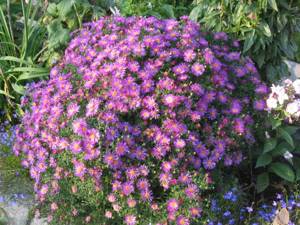
Shrub aster "Starlight"
«
I couldn’t pass by Volzhanka coryshefolia, although it cannot definitely be called spherical, since the dwarf hemispherical bush, like a crown, is crowned with creamy white panicle inflorescences.

Volzhanka kokoroshleistnaya
Hakonechloa is big - are you scared? You haven't seen her yet - incredibly scary... beauty. In this section we will be interested in the “Aureola” variety with light golden, slightly drooping foliage, which acquires a pinkish tint in the fall.
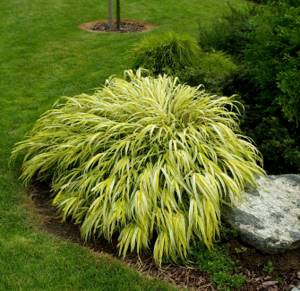
Hakonechloa major "Aureola"
«
Dry sandy areas located in the open sun will not be an obstacle to growing gray fescue; thanks to the narrow linear blue-green leaves that form a lush semicircular bush, the grass remains highly decorative from spring until frost, as well as alpine armeria.
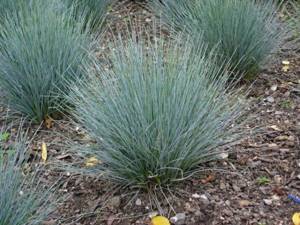
Gray fescue
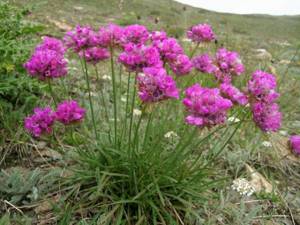
Armeria alpine
Medium-sized and tall plants with a spherical crown reach a height of 50 cm or more; they are not common, since tall herbaceous shoots cannot keep their shape under the influence of their weight. Therefore, the taller the plant, the more spreading its shape.
This category includes varieties of chrysanthemums and perennial asters, which are mainly grown in container culture.
Let's try to group varieties of potted chrysanthemums by color.
White: Axima White, Branspring, Elfie, Gigy White, Ottwa
Yellow: Branbeach Sunny, Brandune, Branfountain Yellow, Branroyal Lemon, Branroyal Yellow, Figary, Gigy Golden, Trumpf Yellow
Orange: Branbeach Orange, Branbrid Orange, Branhalo, Branindio Branindio, Branspice, Molfetta Orange, Cheryl Spicy
Salmonids: Branbeach, Brangala, Paularo Red
Pink: Tereshkova, Branbeach Lilac, Branbunny, Branfountain, Branglory, Brankiss, Branroyal Pink, Rosanna, Trumpf Violet, Ursula
Reds: Branfortune, Branhill Red, Branroyal Branroyal, Branroyal Red, Branstorm, Kamina Red
Such a variety of varieties will satisfy any picky eater.
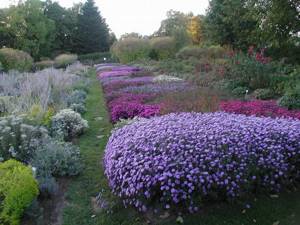
Shrub asters
Natalya Vysotskaya, landscape designer, Ph.D. -X. sciences
© 2014 - 2021, Planting a Garden. All rights reserved.
